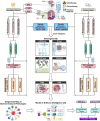Reshaping the systemic tumor immune environment (STIE) and tumor immune microenvironment (TIME) to enhance immunotherapy efficacy in solid tumors
- PMID: 35799264
- PMCID: PMC9264569
- DOI: 10.1186/s13045-022-01307-2
Reshaping the systemic tumor immune environment (STIE) and tumor immune microenvironment (TIME) to enhance immunotherapy efficacy in solid tumors
Abstract
The development of combination immunotherapy based on the mediation of regulatory mechanisms of the tumor immune microenvironment (TIME) is promising. However, a deep understanding of tumor immunology must involve the systemic tumor immune environment (STIE) which was merely illustrated previously. Here, we aim to review recent advances in single-cell transcriptomics and spatial transcriptomics for the studies of STIE, TIME, and their interactions, which may reveal heterogeneity in immunotherapy responses as well as the dynamic changes essential for the treatment effect. We review the evidence from preclinical and clinical studies related to TIME, STIE, and their significance on overall survival, through different immunomodulatory pathways, such as metabolic and neuro-immunological pathways. We also evaluate the significance of the STIE, TIME, and their interactions as well as changes after local radiotherapy and systemic immunotherapy or combined immunotherapy. We focus our review on the evidence of lung cancer, hepatocellular carcinoma, and nasopharyngeal carcinoma, aiming to reshape STIE and TIME to enhance immunotherapy efficacy.
Keywords: Immunotherapy; Radiotherapy; Single-cell transcriptomics; Systemic tumor immune environment (STIE); Tumor immune microenvironment (TIME).
© 2022. The Author(s).
Conflict of interest statement
The authors declare that they have no competing interests.
Figures







References
-
- Duan J, Cui L, Zhao X, Bai H, Cai S, Wang G, et al. Use of immunotherapy with programmed cell death 1 versus programmed cell death ligand 1 inhibitors in patients with cancer: a systematic review and meta-analysis. JAMA Oncol. 2020;6(3):375–384. doi: 10.1001/jamaoncol.2019.5367. - DOI - PMC - PubMed
Publication types
MeSH terms
Grants and funding
LinkOut - more resources
Full Text Sources
Medical

